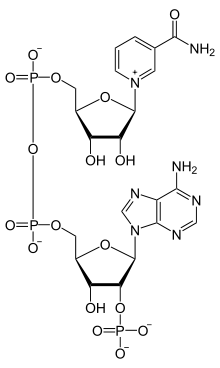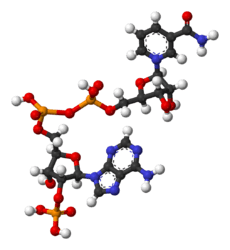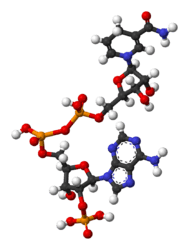Nicotinamide adenine dinucleotide phosphate
Nicotinamide adenine dinucleotide phosphate, abbreviated NADP+ or, in older notation, TPN (triphosphopyridine nucleotide), is a cofactor used in anabolic reactions, such as the Calvin cycle and lipid and nucleic acid syntheses, which require NADPH as a reducing agent. It is used by all forms of cellular life.[1]
 | |
| Identifiers | |
|---|---|
3D model (JSmol) |
|
| ChEBI | |
| ChEMBL | |
| ChemSpider | |
| MeSH | NADP |
PubChem CID |
|
| |
| |
| Properties | |
| C21H29N7O17P3 | |
| Molar mass | 744.416 g·mol−1 |
Except where otherwise noted, data are given for materials in their standard state (at 25 °C [77 °F], 100 kPa). | |
| Infobox references | |
NADPH is the reduced form of NADP+. NADP+ differs from NAD+ by the presence of an additional phosphate group on the 2' position of the ribose ring that carries the adenine moiety. This extra phosphate is added by NAD+ kinase and removed by NADP+ phosphatase.[2]
Biosynthesis
NADP+
In general, NADP+ is synthesized before NADPH is. Such a reaction usually starts with NAD+ from either the de-novo or the salvage pathway, with NAD+ kinase adding the extra phosphate group. NAD(P)+ nucleosidase allows for synthesis from nicotinamide in the salvage pathway, and NADP+ phosphatase can convert NADPH back to NADH to maintain a balance.[1] Some forms of the NAD+ kinase, notably the one in mitochondria, can also accept NADH to turn it directly into NADPH.[3][4] The prokaryotic pathway is less well understood, but with all the similar proteins the process should work in a similar way.[1]
NADPH
NADPH is produced from NADP+. The major source of NADPH in animals and other non-photosynthetic organisms is the pentose phosphate pathway, by glucose-6-phosphate dehydrogenase (G6PDH) in the first step. The pentose phosphate pathway also produces pentose, another important part of NAD(P)H, from glucose. Some bacteria also use G6PDH for the Entner–Doudoroff pathway, but NADPH production remains the same.[1]
Ferredoxin-NADP+ reductase, present in all domains of life, is a major source of NADPH in photosynthetic organisms including plants and cyanobacteria. It appears in the last step of the electron chain of the light reactions of photosynthesis. It is used as reducing power for the biosynthetic reactions in the Calvin cycle to assimilate carbon dioxide and help turn the carbon dioxide into glucose. It has functions in accepting electrons in other non-photosynthetic pathways as well: it is needed in the reduction of nitrate into ammonia for plant assimilation in nitrogen cycle and in the production of oils.[1]
There are several other lesser-known mechanisms of generating NADPH, all of which depend on the presence of mitochondria in eukaryotes. The key enzymes in these carbon-metabolism-related processes are NADP-linked isoforms of malic enzyme, isocitrate dehydrogenase (IDH), and glutamate dehydrogenase. In these reactions, NADP+ acts like NAD+ in other enzymes as an oxidizing agent.[5] The isocitrate dehydrogenase mechanism appears to be the major source of NADPH in fat and possibly also liver cells.[6] These processes are also found in bacteria. Bacteria can also use a NADP-dependent glyceraldehyde 3-phosphate dehydrogenase for the same purpose. Like the pentose phosphate pathway, these pathways are related to parts of glycolysis.[1]
NADPH can also be generated through pathways unrelated to carbon metabolism. The ferredoxin reductase is such an example. Nicotinamide nucleotide transhydrogenase transfers the hydrogen between NAD(P)H and NAD(P)+, and is found in eukaryotic mitochondria and many bacteria. There are versions that depend on a proton gradient to work and ones that do not. Some anaerobic organisms use NADP+-linked hydrogenase, ripping a hydride from hydrogen gas to produce a proton and NADPH.[1]
Function
NADPH provides the reducing equivalents for biosynthetic reactions and the oxidation-reduction involved in protecting against the toxicity of reactive oxygen species (ROS), allowing the regeneration of glutathione (GSH).[7] NADPH is also used for anabolic pathways, such as cholesterol synthesis and fatty acid chain elongation.
The NADPH system is also responsible for generating free radicals in immune cells by NADPH oxidase. These radicals are used to destroy pathogens in a process termed the respiratory burst.[8] It is the source of reducing equivalents for cytochrome P450 hydroxylation of aromatic compounds, steroids, alcohols, and drugs.
Enzymes that use NADP(H) as a coenzyme
- Adrenodoxin reductase: This enzyme is present ubiquitously in most organisms.[9] It transfers two electrons from NADPH to FAD. In vertebrates, it serves as the first enzyme in the chain of mitochondrial P450 systems that synthesize steroid hormones.[10]
Enzymes that use NADP(H) as a substrate
In 2018 and 2019, the first two reports of enzymes that catalyze the removal of the 2' phosphate of NADP(H) in eukaryotes emerged. First, the cytoplasmic protein MESH1 (Q8N4P3),[11] then the mitochondrial protein nocturnin[12][13] were reported. Of note, the structures and NADPH binding of MESH1 (5VXA) and nocturnin (6NF0) are not related.
 NADP+
NADP+ NADPH
NADPH
References
- Spaans SK, Weusthuis RA, van der Oost J, Kengen SW (2015). "NADPH-generating systems in bacteria and archaea". Frontiers in Microbiology. 6: 742. doi:10.3389/fmicb.2015.00742. PMC 4518329. PMID 26284036.
- Kawai S, Murata K (April 2008). "Structure and function of NAD kinase and NADP phosphatase: key enzymes that regulate the intracellular balance of NAD(H) and NADP(H)". Bioscience, Biotechnology, and Biochemistry. 72 (4): 919–30. doi:10.1271/bbb.70738. PMID 18391451.
- Iwahashi Y, Hitoshio A, Tajima N, Nakamura T (April 1989). "Characterization of NADH kinase from Saccharomyces cerevisiae". Journal of Biochemistry. 105 (4): 588–93. doi:10.1093/oxfordjournals.jbchem.a122709. PMID 2547755.
- Iwahashi Y, Nakamura T (June 1989). "Localization of the NADH kinase in the inner membrane of yeast mitochondria". Journal of Biochemistry. 105 (6): 916–21. doi:10.1093/oxfordjournals.jbchem.a122779. PMID 2549021.
- Hanukoglu I, Rapoport R (Feb–May 1995). "Routes and regulation of NADPH production in steroidogenic mitochondria". Endocrine Research. 21 (1–2): 231–41. doi:10.3109/07435809509030439. PMID 7588385.
- Palmer, Michael. "10.4.3 Supply of NADPH for fatty acid synthesis". Metabolism Course Notes. Archived from the original on 6 June 2013. Retrieved 6 April 2012.
- Rush GF, Gorski JR, Ripple MG, Sowinski J, Bugelski P, Hewitt WR (May 1985). "Organic hydroperoxide-induced lipid peroxidation and cell death in isolated hepatocytes". Toxicology and Applied Pharmacology. 78 (3): 473–83. doi:10.1016/0041-008X(85)90255-8. PMID 4049396.
- Ogawa K, Suzuki K, Okutsu M, Yamazaki K, Shinkai S (October 2008). "The association of elevated reactive oxygen species levels from neutrophils with low-grade inflammation in the elderly". Immunity & Ageing. 5: 13. doi:10.1186/1742-4933-5-13. PMC 2582223. PMID 18950479.
- Hanukoglu I (December 2017). "Conservation of the Enzyme-Coenzyme Interfaces in FAD and NADP Binding Adrenodoxin Reductase-A Ubiquitous Enzyme". Journal of Molecular Evolution. 85 (5–6): 205–218. Bibcode:2017JMolE..85..205H. doi:10.1007/s00239-017-9821-9. PMID 29177972.
- Hanukoglu I (December 1992). "Steroidogenic enzymes: structure, function, and role in regulation of steroid hormone biosynthesis". The Journal of Steroid Biochemistry and Molecular Biology. 43 (8): 779–804. doi:10.1016/0960-0760(92)90307-5. PMID 22217824.
- Ding CKC, Rose J, Wu J, Sun T, Chen KY, Chen PH, Xu E, Tian S, Akinwuntan J, Guan Z, Zhou P, Chi JTA (2018). "Mammalian stringent-like response mediated by the cytosolic NADPH phosphatase MESH1". bioRxiv. doi:10.1101/325266.
- Estrella MA, Du J, Chen L, Rath S, Prangley E, Chitrakar A, Aoki T, Schedl P, Rabinowitz J, Korennykh A (2019). "The Metabolites NADP+ and NADPH are the Targets of the Circadian Protein Nocturnin (Curled)". bioRxiv. doi:10.1101/534560.
- Estrella MA, Du J, Chen L, Rath S, Prangley E, Chitrakar A, et al. (May 2019). "+ and NADPH are the targets of the circadian protein Nocturnin (Curled)". Nature Communications. 10 (1): 2367. doi:10.1038/s41467-019-10125-z. PMC 6542800. PMID 31147539.